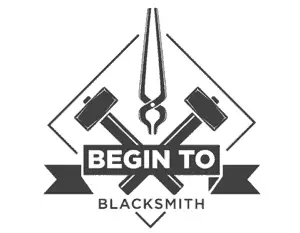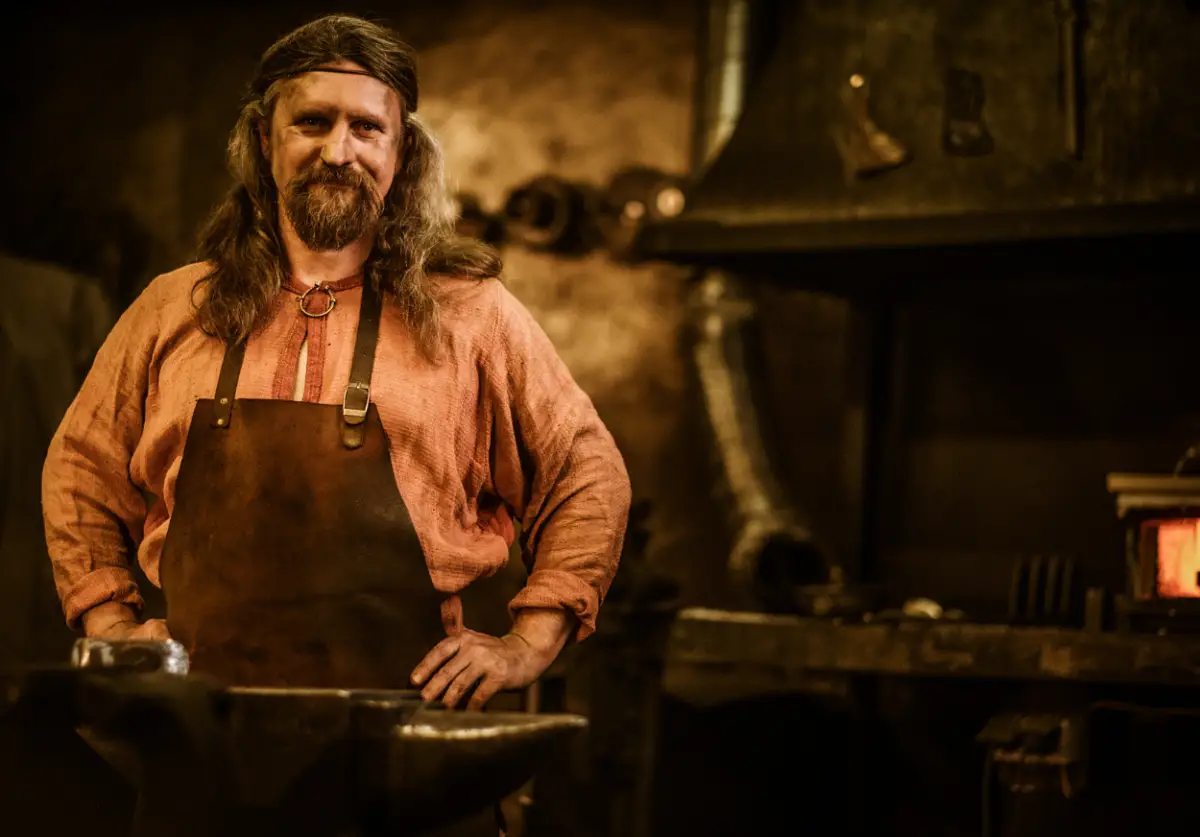Getting started with blacksmithing can potentially be a ton of fun. However, what’s not fun is having to make mistakes and struggle doing even the most basic blacksmithing projects. If you’re not taking classes from a professional smith, then you’re probably making a ton of beginner mistakes that could save you tons of time and effort.
When I started off as a beginner blacksmith, I wish I had someone who could help me avoid some of the beginner mistakes that I made. Since I didn’t have that opportunity years ago, I’m going to share with you some of the most important things I’ve learned that every beginner blacksmith needs to know.
As such, here are the 11 most important blacksmithing tips that every beginner should keep in mind when working on a project.
1. Make sure to heat your stock enough
When beginner blacksmiths first start out, one of the biggest mistakes that they make is understanding how much time it takes to heat up a piece of metal properly. Often, beginners underestimate how hot their metal really is, and as such, struggle to effectively change the shape of the metal.
In my opinion, wait until your metal is a bright orange, if possible. At the minimum, wait for it to be a dark orange before you start striking away at your metal. Often times, beginner blacksmiths think that getting your metal to be a dark red is good enough, but the reality is that the only thing you will accomplish is to leave hammer imprints on your stock. If there a time and place for striking metal when its only red? Sure, especially if you’re going for more of a ‘hammered’ look to your projects. Most of the time, however, you’re not going to gain much from it.
If you’re working with something that’s too thin or a little fragile, failing to heat your stock up enough could cause you to break it by accident. Instead, make sure you heat your up metal adequately before you start. If you’re unsure, take your time and go a little beyond what you normally would do.
2. Manage your forge’s temperature
If you’re working with a gas forge (which is what I recommend most beginner blacksmiths to use) then managing your heat won’t be as difficult as it would be for other types of forges. However, if your one of the many smiths out there using a coal or wood fire forge, then you need to pay close attention to how hot your fire is.
For some projects out there, like if you’re welding something, you’re going to need to make sure your temperature remains pretty hot, upwards of 2,400 degrees Fahrenheit or more. If you are not paying attention to your forge and your temperature can easily dip.
If that happens, you’re going to have to wait a bit for it to heat up again, wasting time and just slowing things down unnecessarily. It’s easy to end up forgetting about your fire and instead just become overly focused on your project, and I say that from experience.
Every few minutes or so, make sure to take a break and check to make sure you forge hasn’t cooled off too much. Of course, getting a gas forge makes this process much simpler, but I understand not everyone is willing to fork out the cash (or simply prefer more traditional coal or wood-fire forges instead).
3. You CAN see your metal’s glow in the daylight
There’s this idea floating around that, in the daylight, you can’t really tell just how hot your stock is. Don’t get me wrong, it’s definitely true that it’s a bit harder to tell, and its easier to work in the dark or indoors than it is outside in the sun. However, if you have to work outdoors, don’t let it stop you.
The reality is that you definitely can see how hot your stock is in the daylight, you just have to be a little crafty. Put your hand or something else over your metal to create a shadow. This will help you see more clearly just how hot your stock is and is a crucial tip I learned to help me during a bright, hot day.
4. Take your time and have a rhythm
Don’t be in a rush to get started on your project. Not only should you make sure you’ve heated up your stock enough before beginning, but you also shouldn’t be overeager in your hammer strokes either.
It’s hard to undo something when it comes to blacksmithing. Once you’ve delivered a strike with your hammer, you can’t really take it back or reverse it. The indent has been made. The real problem comes when you’re doing a delicate project, say a hand-forged hairpin, something that involves a thin metal piece that can easily be broken if you’re in a rush or overdo it.
Slow and steady wins the race, and that goes for blacksmithing as well. If you accidentally break something because you were in a hurry, you’re going to have to start all over again. You could easily end up wasting much more time than if you had just taken it slowly from the beginning.
5. Empty your ashes often
While it might not seem like that big of a deal, over time, your ashtray can accumulate a lot of ash during a blacksmithing session. The reason why this can be a problem is that, if your ash trap is clogged up, it could end up sending sparks all over the place.
Again, if you have a good setup and there’s nothing around you that is flammable, this shouldn’t be much of a fire risk. If anything, a hot spark could hit your face or your arms and give you a bit of a scar. It’s not the end of the world, but it’s not a risk you need to take.
Just clean your ash trap often, and you won’t have to worry about this sort of thing.
6. Prepare your tools in advance
When you are planning to start working on an exciting project, make sure you have all your materials and all the tools you need to be laid out beforehand. The last thing you need is to realize you’ve forgotten to find a certain type of tool and end up spending half an hour trying to find it. Your stock is going to get cold (and maybe even your forge too), and you’re going to need to reheat them both up all over again.
It might sound pretty basic, but just make sure you’ve planned out what you need in advance. Have everything laid out beside you as you start. You wouldn’t believe how many times I’ve started a project, only to realize I forgot to buy a crucial component from a hardware store. Many hours were wasted on these types of mistakes. Don’t let them happen to you.
7. See how other blacksmiths do it
If you have an idea of what you want to make, even if you’ve already planned out how you’re going to do it, it’s a good idea to see how other blacksmiths tackle a similar project. If you go on YouTube, you can easily find dozens of blacksmithing channels that likely will have covered your particular project before. See what they’re doing, you could learn something from it.
Often times, even if I’ve already decided how to go about making something after I see a video on someone else using a different approach, I end up modifying my own plans and incorporating their technique. This is especially true when making something more complicated (swords, for example), where there’s often a lot of variance in how different blacksmiths tackle an issue.
8. Know what materials you can and can’t use
I’ve always warned beginner blacksmiths to know what kind of metal they are using. While using any scrap metal you find lying around might sound like a good idea, if you have no clue what you’re working with, there is a chance things can go horribly wrong.
For example, if you’re trying to weld something, welding steel is much easier than trying to weld iron, mainly due to the temperature difference required to weld the two metals. However, things can be much more serious. If you accidentally used some galvanized metal in your projects, heating it up could release dangerous gases that could send you to the hospital (or even kill you).
Whenever you start a project, know exactly what kind of metal is recommended. If you’re doing your own thing, just make sure the scrap you’re playing around with is safe to heat up.
9. Know your limits
Beginner blacksmiths tend to be pretty ambitious in regards to what projects they want to tackle. Often times, this can be something like a sword, or a fancy knife. However, it’s quite easy to end up overestimating your abilities and bit off more than you can chew.
Even projects that seem relatively simple on paper can prove to be much more complicated than first imagined. Earlier this week I wrote a basic guideline on how to forge your own rapier. Despite simplifying the project down to just the basic steps (no fancy hilts or anything), it ends up being quite complicated to teach to a complete beginner.
There’s definitely a time and place for when you should start working on your dream projects. Just remember that if any video, book, or blog out there makes something look like a cakewalk, it’s probably trickier than it first appears.
10. Have a coach
While it’s fun to hammer away at something just for the fun of it, sooner or later, beginner blacksmiths will need to learn from an expert in order to improve their skill levels. Don’t get me wrong; there are tons of videos and blogs out there on the subject that you can spend months learning everything there is to know.
However, nothing really matches having a person that you can personally turn to for advice and training. There are plenty of blacksmithing courses out there for you to take, and they can be highly beneficial. However, I’m also talking about having a mentor or coach that works with you directly.
You don’t even necessarily need to pay money. Go to events and conventions, meet people, make friends, and exchange ideas back and forth. If you end up befriending a professional or an expert blacksmith, you could always shoot some questions over his way from time to time.
Regardless, having someone whose better than you that can teach you (in one way or another) is incredibly important if you want to move past the beginner blacksmith stage sooner rather than flounder around while you figure things out.
11. Focus on having fun
A lot of times, when people want to seriously get better at any skill or a hobby, they end up doing things over and over again to master a particular skill set. For pianists, its playing scales. For basketball players, it might be dribbling or taking free throws. Often times for blacksmiths, it’s making one hundred nails or forging one hundred S hooks.
While your skills as a blacksmith is definitely going to improve quickly if you take this kind of approach, it’s going to get boring fast. You’re not really going to have any fun, and its going to feel like a chore.
One of the most important things in life is enjoying what you do. Don’t make blacksmithing another job (unless you really want to, then go ahead). As long as you enjoy yourself and have fun, I guarantee you that your skills as a blacksmith are going to improve.


